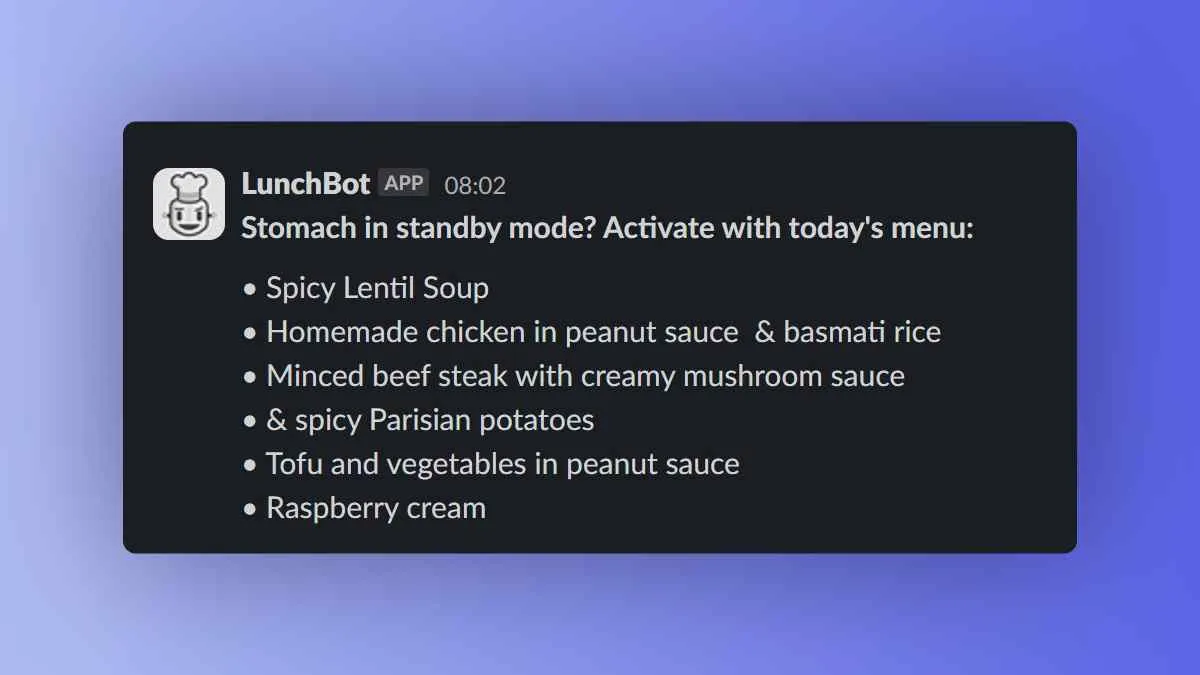Welcome to the LunchBot project, where we explore the development of a real-time lunch menu bot designed to enhance workplace communication. Join us on this journey as we delve into the technologies, challenges, and insights behind building LunchBot.
Introduction
Lunch breaks are an essential part of the workday, providing employees with much-needed sustenance and relaxation. However, deciding what to eat can sometimes be a daunting task, leading to indecision and wasted time. LunchBot aims to solve this problem by providing employees with real-time access to the daily lunch menu, facilitating informed dining choices and streamlining workplace communication.
Technologies Used
Node.js
Node.js serves as the foundation of LunchBot, providing a runtime environment for executing JavaScript code on the server-side. Its event-driven, non-blocking I/O model makes it well-suited for handling asynchronous operations, such as web scraping and API requests.
Cheerio
Cheerio is a fast, flexible, and lightweight library for parsing and manipulating HTML documents using jQuery-style syntax. It plays a crucial role in LunchBot’s web scraping functionality, allowing us to extract menu data from restaurant websites with ease.
Slack API
The Slack API enables seamless integration with Slack, a popular messaging platform used by many workplaces for internal communication. By leveraging the Slack API, LunchBot can deliver real-time menu updates directly to designated Slack channels, keeping employees informed and engaged.
Building LunchBot
Web Scraping
LunchBot fetches daily lunch menus from restaurant websites using web scraping techniques. It utilizes Cheerio to parse HTML content, extract relevant menu information, and format it for display.
Slack Integration
Once the menu data is obtained, LunchBot posts it to designated Slack channels using the Slack API. This integration allows employees to access the daily menu without leaving the Slack environment, promoting efficiency and convenience.
Challenges and Learnings
Throughout the development process, I encountered various challenges and gained valuable insights:
-
Web Scraping: Extracting menu data from restaurant websites posed challenges due to variations in website structures and content formatting. Implementing robust error handling and data parsing techniques was crucial in ensuring reliable data extraction.
-
Slack Integration: Integrating LunchBot with Slack required understanding the Slack API and implementing message formatting according to Slack’s guidelines. Experimentation and documentation referencing helped overcome integration hurdles and achieve seamless communication with Slack.
-
Asynchronous Operations: Handling asynchronous operations, such as web scraping and API requests, required careful management of callbacks and promises. Leveraging Node.js’s asynchronous programming features, including async/await, improved code readability and maintainability.
-
Error Handling: Implementing comprehensive error handling mechanisms was essential, especially when dealing with external dependencies and network operations. Proper error logging and exception handling facilitated effective debugging and troubleshooting.
Conclusion
The development of LunchBot was an enriching experience that allowed me to explore the intersection of technology and workplace communication. By leveraging Node.js, Cheerio, and the Slack API, I was able to create a versatile and efficient solution for providing real-time lunch menu updates to employees.
Moving forward, I plan to continue refining LunchBot’s features, adding support for additional restaurants, and enhancing its user interface. With LunchBot, I aim to revolutionize lunchtime at workplaces, making dining decisions easier and more enjoyable for employees.
Stay tuned for updates on LunchBot’s development journey, and feel free to reach out with any questions or feedback. Happy lunching!
 The LunchBot project aims to streamline workplace communication and dining decisions.
The LunchBot project aims to streamline workplace communication and dining decisions.